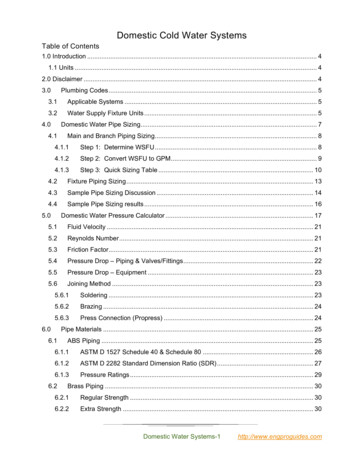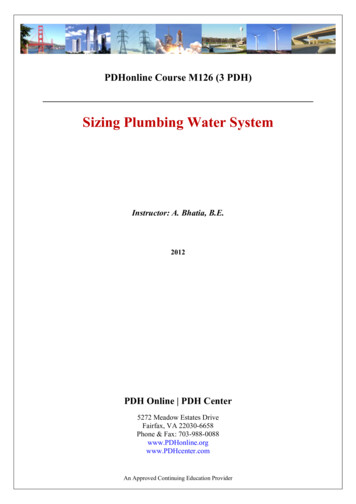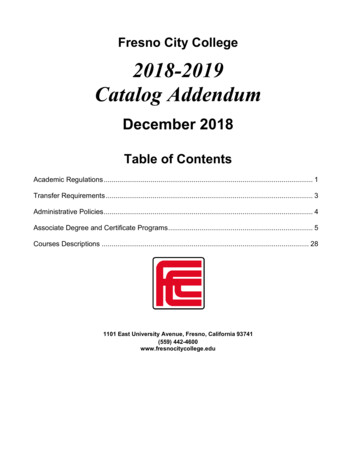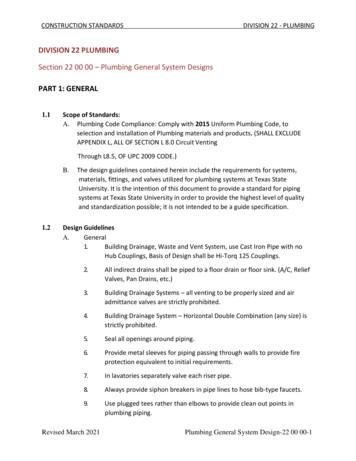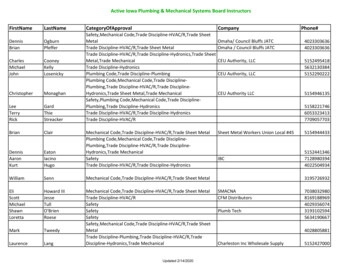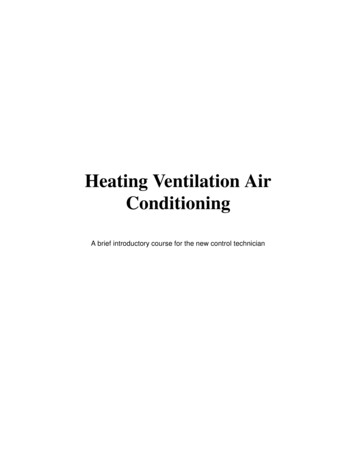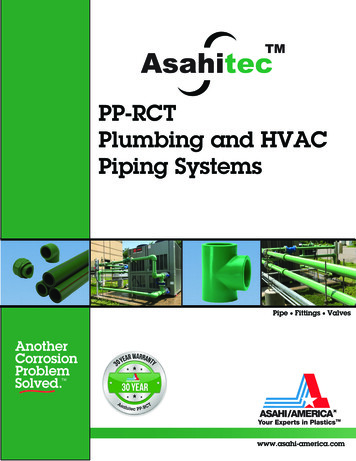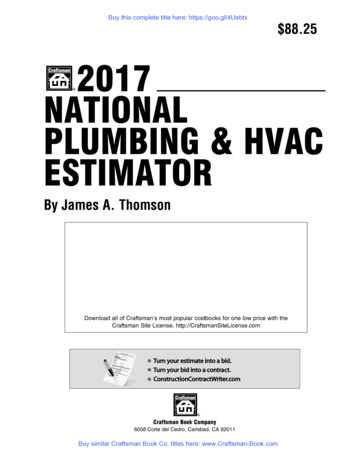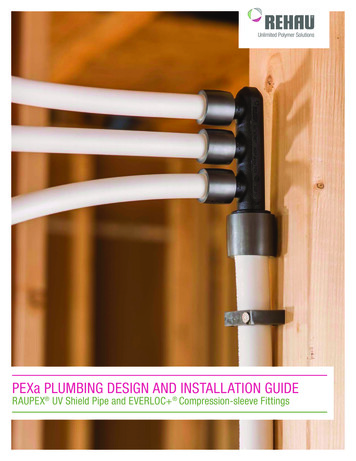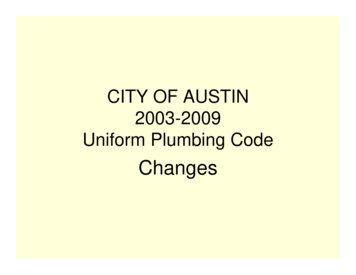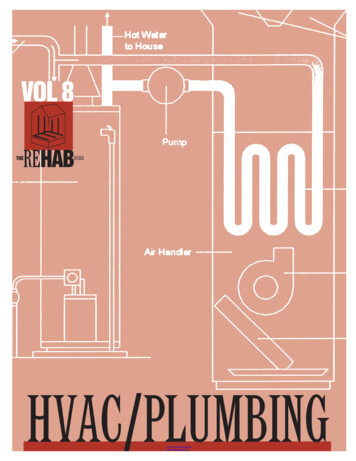
Transcription
VOL 8REHABTHEGUIDEHVAC/PLUMBINGFree Engineering Bookshttps://boilersinfo.com
PATH (Partnership for Advancing Technology in Housing) is a new private/public effort to develop, demonstrate, and gain widespread market acceptance for the “Next Generation” of American housing. Throughthe use of new or innovative technologies the goal of PATH is to improve the quality, durability, environmental efficiency, and affordability of tomorrow’s homes.Initiated at the request of the White House, PATH is managed and supported by the Department ofHousing and Urban Development (HUD). In addition, all Federal Agencies that engage in housing researchand technology development are PATH Partners, including the Departments of Energy and Commerce, aswell as the Environmental Protection Agency (EPA) and the Federal Emergency Management Agency(FEMA). State and local governments and other participants from the public sector are also partners inPATH. Product manufacturers, home builders, insurance companies, and lenders represent private industry in the PATH partnership.To learn more about PATH, please contact:PATHSuite B 133451 7th Street SWWashington, DC 20410202-708-4250 (fax)e-mail: pathnet@pathnet.orgwebsite: www.pathnet.orgDISCLAIMERThe statements and conclusions contained in this report are those of Steven Winter Associates, Inc. anddo not necessarily reflect the views of the Department of Housing and Urban Development. Steven WinterAssociates, Inc. has made every effort to verify the accuracy and appropriateness of the report’s content.However, no guarantee of the accuracy or completeness of the information or acceptability for compliancewith any industry standard or mandatory requirement of any code, law, or regulation is either offered orimplied. The products listed in the report are included only as examples of some available products. Noendorsement, recommendation, or evaluation of these products or their use is given or implied.Free Engineering Bookshttps://boilersinfo.com
H VA C / P L U M B I N GVOLUME 8 OF THE REHAB GUIDETABLE OF CONTENTSFOREWORD 31. INTRODUCTION 42. HVAC DESIGN & ENGINEERING 63. DISTRIBUTION SYSTEMS 114. HEATING 195. COOLING 256. HEAT PUMPS 317. INDOOR AIR QUALITY 368. CONTROLS 429. FIREPLACES & CHIMNEYS 4710. DOMESTIC HOT WATER HEATING 5411. PLUMBING DESIGN & ENGINEERING 6112. WATER SUPPLY & DISTRIBUTION SYSTEMS 6313. DRAIN,WASTE, & VENT SYSTEMS 6714. FUEL SUPPLY SYSTEMS 7315. APPLIANCE VENTS & EXHAUSTS 7516. FIRE PROTECTION SYSTEMS 78APPENDIX: PROFESSIONAL ASSOCIATIONS & RESEARCH CENTERS 81Prepared for:U.S. Department of Housingand Urban DevelopmentOffice of Policy Developmentand ResearchPrepared by:Steven Winter Associates, Inc.Building Systems ConsultantsNorwalk, CTContract DUIOOCOOOOO5956August 1999Free Engineering Bookshttps://boilersinfo.com
CREDITSSTEVEN WINTER ASSOCIATES, INC. STAFF MEMBERSWHO WERE INSTRUMENTAL IN THE DEVELOPMENT ANDPRODUCTION OF THIS GUIDEBOOK INCLUDE:Steven WinterPrincipal-in-chargeMichael J. Crosbie, Ph.D., RAProject manager and Editor-in-chiefDiane Griffiths and Donald ClemProject team membersChristoph Weigel and Masaki FurukawaIllustratorsU.S. DEPARTMENT OF HOUSING AND URBAN DEVELOPMENTOFFICE OF POLICY DEVELOPMENT AND RESEARCH, AFFORDABLEHOUSING RESEARCH AND TECHNOLOGY DIVISIONDavid EngelDirectorNelson CarbonellSenior architectGUIDEBOOK DESIGNAndrew P. KnerArt DirectorMichele L. TrombleyAssistant Art DirectorElizabeth RosenSymbolsFree Engineering Bookshttps://boilersinfo.com
FOREWORDPresident Clinton recognizes that research and technological innovation are crucial if America is to meetits affordable housing needs. In 1998, the President introduced a major new initiative: The Partnership forAdvancing Technology in Housing (PATH). This initiative brings together leaders from the home building,product manufacturing, insurance, and financial industries, as well as representatives from federal agencies,to spur housing design and construction innovations.Thanks to the development of new machinery and materials and the creation of new technologiesand techniques, the construction industry has made great progress. But a breakthrough material, a laborsaving tool, or a cost-cutting technique is only valuable if it is widely adopted, which means the constructionindustry must first become aware of these new developments.The Department of Housing and Urban Development can help. We have commissioned a set ofguidebooks that will present state-of-the-art techniques, materials, and technologies for housing rehabilitation. This volume, HVAC/Plumbing, is the eighth of nine guidebooks—known collectively as The RehabGuide—that will appear over the next few years.We are presenting these guidebooks because, like research and technological innovation, housingrehabilitation is an essential component of America’s commitment to provide affordable housing. I ampleased to present this important publication in the hope that it will become a valuable resource that leadsto affordable, high quality rehabilitation, and thus to better housing for all Americans.Andrew Cuomo, SecretaryU.S. Department of Housing and Urban Development3Free Engineering Bookshttps://boilersinfo.com
1INTRODUCTIONThis series of guidebooks has been produced by the U.S. Department of Housing and Urban Developmentto keep the design and construction industry abreast of innovations and state-of-the-art practices in homerehabilitation. As is too often the case, innovative techniques, materials, technologies, and products areslow to make their way into accepted practice. It is evident that such innovations will not advance unlessthe industry is made aware of them and they are tested. The Rehab Guide is intended to accelerate thisprocess by informing builders, architects, engineers, and other housing rehabilitation professionals aboutsuch innovations and state-of-the-art practices.The Rehab Guide was also prompted by the lack of a comprehensive publication to make thedesign and construction industry aware of innovative and cost-saving developments in housing rehabilitation.Professional trade magazines, conferences, and trade shows offer some dissemination of this information,but they are rarely focused exclusively on housing rehabilitation, as this series is, nor are they comprehensive.FOCUS OF THE REHAB GUIDEThe focus of this series is on housing rehabilitation, which is different than home improvement.Rehabilitate means “to restore to good condition,” not necessarily to improve to a state that is significantlydifferent than the original. This is a fine line, but it distinguishes this series from “home improvement”books written for the amateur. The Rehab Guide focuses on building technology, materials, components,and techniques rather than “projects” such as adding a new room, converting a garage into a den, orfinishing an attic. Nor is The Rehab Guide intended to be a “diagnostic” tool; a number of such books arealready available to the industry.The content for this guidebook, HVAC/Plumbing, has been gathered from professionals in thehousing rehabilitation field; manufacturers and suppliers of innovative technologies, materials, components,tools, and equipment; trade shows, conferences, reports, and publications considering such issues; tradeorganizations; and building research centers.A NOTE ON SOURCESA variety of excellent resources exists for information on heating, ventilating, and air-conditioning (HVAC) andplumbing systems and issues. This Old House Heating, Ventilation, and Air Conditioning, published byLittle, Brown and Company, is a comprehensive book on HVAC and water heating system alternatives.Plumbing a House, published by The Taunton Press, is an excellent source for information on plumbing systems. Monthly publications of interest include the Energy Design Update, Environmental Building News,Journal of Light Construction, Home Energy, Old House Journal, This Old House, and Traditional Builder.Helpful information is also accessible via the Internet. Most equipment manufacturers andmonthly magazines have Web sites where specific product information and past articles can be retrieved.The Department of Energy provides a wealth of information on energy conserving techniques and technologies at www.eren.doe.gov/consumerinfo/.LEAD PAINT HAZARD4The hazard of lead paint in houses constructed before the 1980s is not discussed in the The Rehab Guidebecause there is extensive material available from HUD, the Environmental Protection Agency (EPA), and othersources. However, if you are a non-profit or rehab contractor rehabilitating pre-1978 housing for sale or rent,or if you are a homeowner rehabilitating a home for your own use, you are strongly urged to have the hometested for lead paint. This is especially critical if the home will be occupied by young children. Very smallFree Engineering Bookshttps://boilersinfo.com
amounts of lead in paint or dust can poison children if swallowed or inhaled, causing damage to the brain andother organs, resulting in health problems and reduced intelligence. If lead paint is found, it is critical that allrehabilitation be done very carefully to reduce the possibility of lead poisoning to you or your workers. Properwork practices will minimize the risk of spreading lead contamination and increasing occupant exposure.One of the best and most recent sources on this subject is the HUD publication, “Lead Paint Safety:a Field Guide for Painting, Home Maintenance, and Renovation Work.” Another good publication is the EPAbrochure, “Reducing Lead Hazards When Remodeling Your Home.” Both can be obtained by calling theNational Lead Information Center at 800-424-LEAD or by downloading from the web site of the HUD Office ofLead Hazard Control, www.hud.gov/lea. A very comprehensive source is the HUD publication, “Guidelines forthe Evaluation and Control of Lead-Based Paint Hazards in Housing,” which gives guidance on controlling leadhazards, lead paint and rehab work, risk assessment, monitoring, inspections, resident and work site preparation, worker protection, and routine building maintenance. This publication is available through HUD-User;you can also download a copy of this document from the HUD web site at: www.hud.gov:80/lea/learules.html.HUD has new regulations on lead-based paint hazards in federally owned housing and housingreceiving federal assistance. If you will be using HUD funds for rehabilitation through grants, insurance,or other types of assistance, then there are protective procedures that must be followed. The OccupationalSafety and Health Administration web site at www.osha.gov has information on worker protection requirements. In addition, many states and localities have their own rules regarding lead-based paint, whichshould be followed when undertaking rehabilitation.HOW THE GUIDE IS ORGANIZEDNine volumes will eventually make up The Rehab Guide in its entirety, and they are listed on the back coverof this volume. Each one is devoted to distinct elements of the house, and within each volume is a range ofissues that are common to that element of home rehabilitation work. This volume, for example, covers topics from new piping materials for the repair of an existing plumbing system to the criteria for selection of anentirely new central heating system. Each volume addresses a wide range of techniques, materials, and tools,and recommendations based on regional differences around the country. Throughout The Rehab Guide,special attention is given to issues related to energy efficiency, accessible design, and sustainability.The Rehab Guide is written and presented in a format intended for easy use. The spiral boundvolumes open flat so that they can be easily photocopied, and they can be assembled and stored in a single three-ring binder. Within each volume, drawings, photos, and other graphic materials supplement written descriptions of a broad range of items: state-of-the-art and innovative building technology, products,materials, components, construction and management techniques, tools, equipment, software—virtuallyany and all items that make housing rehabilitation more efficient in terms of cost and time. While the content focuses on present technologies and techniques that are currently part of the house-building industry,The Rehab Guide also includes information on materials, products, and procedures from other construction sectors (such as commercial, industrial, institutional) that are relevant to housing rehabilitation.The information is organized in different sections according to rehab subjects, and under headings that make this book easy to understand. “Essential Knowledge” gives the reader a basic overview ofthe important issues related to the section heading. Next, “Techniques, Materials, Tools” presents state-ofthe-art and innovative approaches to accomplishing the work. Each entry is explained in detail, includingits advantages and disadvantages. This makes it easy for readers to compare approaches and choose theone that is most applicable to their particular project. By design, the “Techniques, Materials, Tools” section is an overview, not a detailed description of implementation. “Further Reading” lists the valuableresources relevant to the subject that readers can go to for more detailed information. Finally, “ProductInformation” provides names and addresses of manufacturers of products, materials, systems, and components mentioned in the text so that more information can be obtained. By virtue of their being listedhere, such products are not necessarily being recommended; their existence and availability are beingbrought to the reader’s attention. New products should be carefully evaluated in the field as to their performance. The product lists are not necessarily comprehensive, and we encourage readers to bring newmaterials and products to our attention to be included in later editions of The Rehab Guide.5Free Engineering Bookshttps://boilersinfo.com
2H VA C D E S I G N &ENGINEERING2.1HVAC SYSTEMS OVERVIEWHeating, ventilation, and air-conditioning (HVAC) systems that are properly operating and appropriate forthe home are critical for the comfort and safety of the home occupants. Richard Trethewey of “This OldHouse” states that the home’s HVAC systems and plumbing set the foundation on which the family’s physical comfort and health depend. Their economic well-being is not only affected by the initial purchaseprice, but, perhaps more importantly, by the cost of operating and maintaining the systems.What constitutes an HVAC system is a function of the home, the climate, and the occupants. It issafe to say that all homes have a heating system of some kind, but it is only over the last 20 years that summer air conditioning beyond opening windows became prominent. In 1970, about one-third of new single family homes had central air conditioning; the figure is now over three-quarters. And, the practice ofinstalling mechanical ventilation systems has only matured in the last 10 years with the emphasis on tighterhomes and high-efficiency equipment. Today’s HVAC systems can include smart controls, air filtering,humidification and/or dehumidification (Fig. 1).FIGURE 1HVAC SYSTEM COMPONENTS6Free Engineering Bookshttps://boilersinfo.com
When evaluating the rehabilitation needs of a home’s HVAC system, the appropriateness of the current type of system for meeting the expectations of today’s home occupants needs to be considered. Theyexpect to be comfortable in the winter and summer without paying exorbitant energy bills. While a home withelectric baseboard heating and passive cooling (i.e. natural ventilation, shading, etc., with no equipment)was fairly common and acceptable 20 years ago, the high winter electric bills due to the increased cost ofelectricity and poor level of comfort during the summer have diminished its popularity significantly. Even ifthe baseboard system is in good operating condition, it may be appropriate to consider its replacement.If it is determined that the type of system is appropriate, the system performance must then beconsidered. Are there opportunities to improve the performance of the existing system or is it a wiser decision to simply replace the old system with a newer one? Generally speaking, if the heating system equipment is more than 15 years old or the heat pump or air conditioner is more than 10 years old, it shouldprobably be replaced. The energy savings with the higher efficiency equipment available today will pay forthe new equipment within a few years. The typical new gas furnace sold in 1975 had an efficiency of 63percent; by 1988, the typical efficiency had increased to 75 percent; and, in 1997, 86 percent of the furnaces shipped had efficiencies greater than 80 percent. Nevertheless, replacement is not always the answerand there are a number of alternatives for rehabilitating the existing system.This guideline will review the attributes of many alternatives for rehabilitating HVAC systems. Itdiscusses the advantages and disadvantages of various modifications to existing systems as well as equipment technologies which may be considered for supplementing or replacing the existing system.As a final note before moving into the discussion of alternatives, it is critically important tounderstand how HVAC systems interact with other systems throughout the home. A decision concerningthe kitchen range exhaust vent can cause the gas furnace to backdraft. Under certain circumstances, anattic ventilator can increase cooling loads rather than decrease them by drawing conditioned air upthrough the ceiling. When the old natural-draft furnace is replaced with a closed-combustion system, thehome’s pressure and infiltration rate will be altered, and, as a result, its indoor air quality. Much of theinteraction of these systems revolves around the pressurization and depressurization of spaces. Lack ofconsideration for the effects of various devices on home pressure can result in costly excessive infiltration,damaging condensation in walls, or dangerous levels of carbon monoxide in the home. These issues havebeen enhanced by today’s construction and insulation practices which make homes tighter and thereforeeasier to pressurize or depressurize. It is important to understand and consider the whole-house implications of each system modification. Contractors who are narrowly focused on a particular trade often donot take all of the interactions within the house into consideration.FURTHER READINGBuilding Energy Efficiency, U.S. Congress, Office of Technology Assessment, U.S. Government PrintingOffice, May 1992.This Old House Heating, Ventilation, and Air Conditioning, Richard Trethewey with Don Best, Little,Brown and Company, 1994.Understanding Ventilation, John Bower, The Healthy House Institute, 1995.2.2REPLACEMENT SYSTEM SIZINGIn many instances, the decision will be made to replace the existing heating and cooling system rather thanrehabilitate it. The old system may be well beyond its expected life. Many newer systems are more efficientand can quickly pay for themselves in reduced energy bills. The availability of fuels may have changed(e.g., natural gas may now be available) since the system was originally designed and installed.7Free Engineering Bookshttps://boilersinfo.com
If the old heating and/or cooling system in the house being rehabilitated is beyond retrofittingand needs to be replaced, there are two primary reasons why it should not simply be replaced withanother system of the same size. The old philosophy of “bigger is better” no longer applies. Systems weretraditionally oversized, causing them to cycle on and off frequently. Cycling that results from oversizing isinefficient and hard on the equipment. Also, rehab work may also include the addition of more or betterinsulation, and better performing windows and doors. This will reduce the heating and cooling loads andallow for a smaller capacity system to be installed.A design load analysis should be conducted to determine the current heating and cooling capacityneeds. There are various methods and levels of sophistication for performing these analyses.Most equipment vendors are equipped with worksheets or computer software to estimate theappropriate size of the system for the home. They will typically perform a sizing calculation as part of thesales process. While such a service from the dealer is available at no cost, it should be remembered thatthe dealer is selling equipment, not efficiency. Methods are often over-simplified with factors of safety builtin, resulting in over-sized equipment. An alternative is to size the system yourself. There is a multitude ofbooks available that provide instructions, data tables, and examples for performing system sizing calculations. It is recommended that calculations be performed more than once with different methods andsources to provide confidence in the results. While sizing the system may cost a modest amount of time,lack of experience by the novice estimator may result in mistakes. Basic estimating techniques may alsonot properly account for unique aspects of the home. Another alternative is to hire a consultant to size thesystem. Professional energy specialists and auditors can evaluate the home and provide recommendationson the size and type of equipment. The advantage here is the benefit of an experienced professional whois focused on energy efficiency, but consulting fees may be hefty.FURTHER READINGCooling and Heating Load Calculation Manual, American Society of Heating, Refrigerating and AirConditioning Engineers, Inc., 1791 Tullie Circle, N.E., Atlanta, GA 30329, 404-636-8400.Consumers’ Directory of Certified Efficiency Ratings for Residential Heating and Water HeatingEquipment, Gas Appliance Manufacturers Association.Directory of Certified Unitary Products, Air Conditioning and Refrigeration Institute, 4301 North FairfaxDrive, Suite 425, Arlington, VA 22203; 703-524-8800.Residential Load Calculation Manual J, Air Conditioning Contractors of America, 1712 New HampshireAve., NW, Washington, DC 20009; 202-483-9370.Simplified Design of HVAC Systems, William Bobenhausen, New York: John Wiley & Sons, Inc. 1994.2.3ENERGY SOURCESESSENTIAL KNOWLEDGEThe most common energy sources for residential use are natural gas for space and water heating and electricity for cooling. Other heating energy sources include electricity, oil, propane, and the sun. In a fewinstances, wood or coal may even be the primary heating fuel. Natural gas is a potential energy source forcooling as well.The most appropriate fuel choice for a particular home depends on its availability, price, and theclimate. Some of these factors may have changed since the home was built and the fuel choice that wasmade then may not be the most appropriate choice now. Natural gas, a popular choice now, was not read-8Free Engineering Bookshttps://boilersinfo.com
ily available prior to World War II and embargoes were placed on new gas services for a period in the1970s. Consult the local utilities to determine the availability and rate schedules for the energy alternatives. In most instances, the primary energy sources of electricity, natural gas, and oil should be considered. Old coal-fired systems should be converted to a more-efficient and cleaner fuel alternative such asoil or gas. Various energy sources are discussed below.TECHNIQUES, MATERIALS, TOOLS1. ELECTRICITY AS AN ENERGY SOURCE.In regions with a mild heating season, electricity may be the most appropriate fuel for heating and cooling needs. It is the most logical choice for cooling and, if heating loads are small, any higher cost of electricity will not be a severe penalty. And, in some areas such as the Northwest where hydroelectric plantsprovide much of the electricity, it is quite economical. In the case of electric air conditioners and heatpumps, electricity is not used directly as an energy source but indirectly to pump heat from one locationto another. For heat pumps in the heating mode, the energy source is the sun warming the air for airsource heat pumps and ground for ground-source heat pumps.ADVANTAGES: Electric resistance heating systems are inexpensive to install, reliable, quiet, and clean.Electric air conditioners are the most common type of mechanical cooling. Electric heat pumps can serveboth heating and cooling needs.DISADVANTAGES: Generally the most expensive fuel choice. Service to home may need to be upgraded.Electric resistance heating (not heat pumps) is prohibited by code in some areas.2. NATURAL GAS AS AN ENERGY SOURCE.In most heating-season dominated climates, natural gas is the fuel of choice for space and water heatingneeds. The residential space heating market shares for natural gas are 59%, 72%, and 48%, in the West,Midwest, and Northeast, respectively. Most of the country’s gas processing plants are located in six states:Texas, Louisiana, Oklahoma, Wyoming, Kansas and New Mexico. Canada is another significant source. Theuse of natural gas as a heating fuel surged with the post-World War II construction of thousands of milesof pipeline for transportation (Fig. 2). Transportation costs still make up a large portion of the consumer’sprice for gas. Major investments in the pipeline system during the 1980s and early 1990s improved thesupply to areas in the Northeast, West Coast and Florida. With the deregulation of the gas industry, gasprices fell approximately 50% from 1985 to 1991. Market competition has led to innovation and advancesin technology for the exploration, extraction, and transportation of natural gas.FIGURE 2MAJOR NATURAL GAS PIPELINES9
ADVANTAGES: Generally the least expensive fuel aside from solar energy. No storage tank is required.DISADVANTAGES: Initial installation cost may be high if gas is not already supplied to the home. Not availablein all areas.3. OIL AS AN ENERGY SOURCE.Oil is commonly used for heating in cold climates where natural gas is not readily available. It is typicallymore expensive than gas unless located near a port or refinery or at the end of the natural gas pipeline.The Northeast U.S. is located at the end of the gas pipeline and gas is not available throughout the region.Heating loads are significant and electricity is expensive. Thus, oil has a 36% market share according tothe 1993 census.ADVANTAGES: Generally less costly than electricity.DISADVANTAGES: Potential for supply shortages and dramatic price fluctuations. Storage tank requiredwith associated environmental concerns and regulations (underground tanks, soil contamination, etc.).4. PROPANE AS AN ENERGY SOURCE.Propane, or liquid petroleum gas (LPG), is typically an alternative when electricity is unattractive (usuallybecause of price) and natural gas is not available. Propane comes from natural gas processing and crudeoil refining and approximately 85% of the country’s supply is produced domestically. It is transported ina liquid state by pipeline, rail car, or tank truck to retail markets.ADVANTAGES: Can be used for most gas-fired equipment with only minor modifications.DISADVANTAGES: Requires an on-site storage tank.5. SOLAR AS AN ENERGY SOURCE.The use of solar energy to provide a portion of the home’s space or water heating is a good option in manygeographic areas. Passive systems use building orientation and construction materials to enhance naturalprocesses to collect, store, and distribute heat. Active systems employ pumps and/or fans. Hybrid systemsuse small pumps or fans to enhance the performance of a passive system. Photovoltaic (PV) systems convert solar energy directly to DC power which is inverted to AC power for home use. Unfortunately, the market advancement of this technology is suffering from the costly and limited production of the ultra-puresilicon wafers which are the main component of the PV system (Fig. 3).ADVANTAGES: Minimal operating cost. Environmentally benign.DISADVANTAGES: Initial cost for design and installation. Optimum location issues and aesthetics.FIGURE 3PHOTOVOLTAIC PANEL WITH SILICON WAFERSFURTHER READING10Passive Solar Design Strategies: Guidelines for Home Builders, Passive Solar Industries Council, 1331H Street NW, Suite 1000, Washington, D.C. 20005; 202-628-7400.Simplified Design of HVAC Systems, William Bobenhausen, New York: John Wiley & Sons, Inc. 1994.
3DISTRIBUTIONSYSTEMSESSENTIAL KNOWLEDGEBy the end of World War I, the majority of urban homes and many rural homes were centrally heated bya hot-air, hot-water, or steam distribution system. Today there are four basic methods or media for distributing heat in the home: steam, air, water, and electric resistance. All have unique characteristics whichmay or may not be desirable for the house being rehabilitated.Steam is one of the oldest types of central heat distribution systems. A boiler produces steampiped through the house to radiators, which provide concentrated heating surfaces in each room. Suchsystems are either one-pipe or two-pipe. One-pipe systems require a larger pipe because steam rises tothe radiators while condensate returns in the same pipe from the radiators to the boiler. If the single pipeis too small, steam will force condensate back up the pipe, causing noise as steam slugs through pocketsof water. Two-pipe systems use smaller pipe but twice as much of it because separate steam supply andcondensate return lines are installed. Gravity or a condensate pump may be used to return the condensateto the boiler, depending on the height of the condensate piping relative to the boiler. Two-pipe systemsinstalled after World War I include “steam traps” to prevent steam from getting into the return piping.Air is by far the most common distribution medium for heating and cooling systems. Forced-airheating systems were used in 63% of the homes in the U.S., according to 1993 census data. Original “gravity” air distribution systems relied on natural convection. Heated warm air woul
HVAC/PLUMBING VOLUME 8 OF THE REHAB GUIDE Prepared for: U.S. Department of Housing and Urban Development Office of Policy Development and Research Prepared by: Steven Winter Associates, Inc. Building Systems Consultants Norwalk, CT Contract DUIOOCOOOOO5956 August 1999 TABLE OF CONTENTS FOREWORD 3 1. INTRODUCTION 4 2. HVAC DESIGN & ENGINEERING 6 3.
